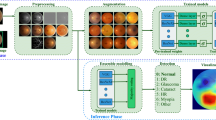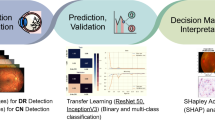Abstract
Diabetic Retinopathy (DR) is one of the leading causes of blindness in all age groups. Inadequate blood supply to the retina, retinal vascular exudation, and intraocular hemorrhage cause DR. Despite recent advances in the diagnosis and treatment of DR, this complication remains a challenging task for physicians and patients. Hence, a comprehensive and automated technique for DR screening is necessary, which will give early detection of this disease. The proposed work focuses on 16 class classification method using Support Vector Machine (SVM) that predict abnormalities individually or in combination based on the selected class. Our proposed work comprises Gaussian mixture model (GMM), K-means, Maximum a Posteriori (MAP) algorithm, Principal Component Analysis (PCA), Grey level co-occurrence matrix (GLCM), and SVM for disease diagnosis using DR. The proposed method provides an accuracy of 77.3% on DIARETDB1 dataset. We expect this low computational cost will be helpful in the medicine and diagnosis of DR.







Similar content being viewed by others
Code availability
Code will be made on reasonable request to the authors by the reader.
References
Allen DA, Yaqoob MM, Harwood SM (2005) Mechanisms of high glucose-induced apoptosis and its relationship to diabetic complications. J Nutr Biochem 16:705–713. https://doi.org/10.1016/j.jnutbio.2005.06.007
Rubsam A, Parikh S, Fort PE (2018) Role of Inflammation in Diabetic Retinopathy. Int J Mol Sci 19:942–973. https://doi.org/10.3390/ijms19040942
Faust O, Rajendra Acharya U, Ng E-K, Ng K-H, Suri JS (2012) Algorithms for the automated detection of diabetic retinopathy using digital fundus images: a review. J Med Syst 36:145–157. https://doi.org/10.1007/s10916-010-9454-7
Hashim MF, Hashim SZ (2014) Diabetic retinopathy lesion detection using region-based approach. In: 8th. Malaysian Software Engineering Conference (MySEC) IEEE pp 306–310. https://doi.org/10.1109/MySec.2014.6986034
Zayit-Soudry S, Moroz I, Loewenstein A (2007) Retinal pigment epithelial detachment. Surv Ophthalmol 52:227–243. https://doi.org/10.1007/978-3-319-56133-2
Yang D, Cao D, Huang Z et al (2019) Macular capillary perfusion in chinese patients with diabetic retinopathy obtained with optical coherence tomography angiography. Ophthalmic Surg Lasers Imaging Retina 50:e88–e95. https://doi.org/10.3928/23258160-20190401-12
García E, María CI, Sánchez MI, López DA, Hornero R (2009) Neural network based detection of hard exudates in retinal images. Comput Methods Programs Biomed 93:9–19. https://doi.org/10.1016/j.jnutbio.2005.06.007
Schmidt D (2008) The mystery of cotton-wool spots-a review of recent and historical descriptions. Eur J Med Res 13:231–266
Carrera EV, Gonzalez A, Carrera R (2017) Automated detection of diabetic retinopathy using SVM. IEEE XXIV international conference on electronics, electrical engineering and computing (INTERCON), pp 1–4. https://doi.org/10.1109/INTERCON.2017.8079692
Foeady AZ, Novitasari DCR, Asyhar AH, Firmansjah M (2018) Automated diagnosis system of diabetic retinopathy using GLCM method and SVM classifier. In: International Conference on Electrical Engineering. Computer Science and Informatics (EECSI) IEEE pp 154–160.https://doi.org/10.1109/EECSI.2018.8752726
Kandhasamy JP, Balamurali S, Kadry S et al (2020) Diagnosis of diabetic retinopathy using multi level set segmentation algorithm with feature extraction using SVM with selective features. Multimed Tools Appl 79:10581–10596. https://doi.org/10.1007/s11042-019-7485-8
Bhardwaj C, Jain S, Sood M (2020) Diabetic retinopathy lesion discriminative diagnostic system for retinal fundus images. Adv Biomed Eng 9:71–82. https://doi.org/10.14326/abe.9.71
Zhu CZ, Hu R, Zou BJ et al (2019) Automatic diabetic retinopathy screening via cascaded framework based on image-and lesion-level features fusion. J Comput Sci Technol 34:1307–1318. https://doi.org/10.1007/s11390-019-1977-x
M. Purandare, K. Noronha (2016) Hybrid System for Automatic Classification of Diabetic Retinopathy using Fundus images. In: International Conference on Green Engineering and Technologies (ICGET) IEEE, pp. 1–5. https://doi.org/10.1109/GET.2016.7916623
Jayabalan S, Pratheeksha P, Bolar NS, Malavika N (2020) Prediction of diabetic retinopathy using SVM algorithm. J Crit Rev 7:1702–1711
Roy A, Dutta D, Bhattacharya P, Choudhury S (2017) Filter and fuzzy C means based feature extraction and classification of diabetic retinopathy using support vector machines. In: International Conference on Communication and Signal Processing (ICCSP) IEEE pp 1844–1848. https://doi.org/10.1109/ICCSP.2017.8286715
Kamil R, Al-Saedi K, Al-Azawi R (2018) An accurate system to measure the diabetic retinopathy using SVM classifier. Ciencia e Tecnica Vitivinıcola 33:135–139
Kaur S, Singh D (2018) Early detection and classification of diabetic retinopathy using empirical transform and SVM. Comput Vis Bio Inspired Comput (Springer). https://doi.org/10.1007/978-3-319-71767-8_92
Kumar S, Kumar B (2018) Diabetic retinopathy detection by extracting area and number of microaneurysm from colour fundus image. In: 5th International Conference on Signal Processing and Integrated Networks (SPIN) IEEE. pp 359–364. https://doi.org/10.1109/SPIN.2018.8474264
Adal KM, Van Etten PG, Martinez JP, Rouwen KW, Vermeer KA, van Vliet LJ (2017) An automated system for the detection and classification of retinal changes due to red lesions in longitudinal fundus images. IEEE Trans Biomed Eng 65:1382–1390. https://doi.org/10.1109/TBME.2017.2752701
Frazao LB, Theera-Umpon N, Auephanwiriyakul S (2019) Diagnosis of diabetic retinopathy based on holistic texture and local retinal features. Inf Sci 475:44–66. https://doi.org/10.1016/j.ins.2018.09.064
Alyoubi WL, Abulkhair MF, Shalash WM (2021) Diabetic retinopathy fundus image classification and lesions localization system using deep learning. Sensors 21:3704. https://doi.org/10.3390/s21113704
Xu Y, Zhou Z, Li X, Zhang N, Zhang M, Wei P (2021) Ffunet: Feature fusion u-net for lesion segmentation of diabetic retinopathy. BioMed Res Int. https://doi.org/10.1155/2021/6644071
Shankar K, Sait ARW, Gupta D, Lakshmanaprabu S, Khanna A, Pandey HM (2020) Automated detection and classification of fundus diabetic retinopathy images using synergic deep learning model. Pattern Recogn Lett 133:210. https://doi.org/10.1016/j.patrec.2020.02.026
Qiao L, Zhu Y, Zhou H (2020) Diabetic retinopathy detection using prognosis of microaneurysm and early diagnosis system for non-proliferative diabetic retinopathy based on deep learning algorithms. IEEE Access 8:104292. https://doi.org/10.1109/ACCESS.2020.2993937
Bilal A, Sun G, Li Y, Mazhar S, Khan AQ (2021) Diabetic retinopathy detection and classification using mixed models for a disease grading database. IEEE Access 9:23544. https://doi.org/10.1109/access.2021.3056186
Yan Z, Han X, Wang C, Qiu Y, Xiong Z, Cui S (2019) In: 2019 IEEE 16th International Symposium on Biomedical Imaging (ISBI 2019) (IEEE, 2019), pp 597–600. Doi: https://doi.org/10.1109/ISBI.2019.8759579
Goceri E, Dura E (2018) Comparison of weighted k-means clustering approaches. International Conference on Mathematical Analysis and Applications.
Goceri E (2013) A comparative evaluation for liver segmentation from spir images and a novel level set method using signed pressure force function (Izmir Institute of Technology (Turkey) pp 1–136. http://library.iyte.edu.tr/tezler/doktora/elektrik-elektronikmuh/T001097.pdf
Goceri E (2011) Automatic kidney segmentation using gaussian mixture model on MRI sequences. Electr Power Syst Comput (Springer). https://doi.org/10.1007/978-3-642-21747-0_4
Goceri E, Songul C (2017) Automated detection and extraction of skull from MR head images: preliminary results. In: International Conference on Computer Science and Engineering (UBMK) IEEE pp 171–176. https://doi.org/10.1109/UBMK.2017.8093370
Goceri E (2018) Fully automated and adaptive intensity normalization using statistical features for brain MR images: Celal Bayar University. J Sci 14(1):125–134. https://doi.org/10.18466/cbayarfbe.384729
Goceri E (2017) Intensity normalization in brain MR images using spatially varying distribution matching. In: 11th International Computer Graphics, Visualization, Computer Vision and Image Processing (CGVCVIP) 300–304
Funding
No funding was involved in the present work.
Author information
Authors and Affiliations
Contributions
Conceptualization was done by MH and SM. All the literature reading and data gathering were performed by MH. All the experiments and coding was performed by MH. The formal analysis was performed by MH and SM. Manuscript writing original draft preparation was done by MH. Review and editing was done by MH, SM, AB and MK. Visualization work was carried out by MH and SM.
Corresponding author
Ethics declarations
Conflict of interest
Authors M. Hardas, S. Mathur, A. Bhaskar and M. Kalla declare that there has been no conflict of interest.
Consent to participate
This article does not contain any studies with animals or humans performed by any of the authors. Informed consent was taken from all the participants whose fundus images were used as and when required. All the necessary permissions were obtained from Institute Ethical committee and concerned authorities.
Consent for publication
Authors have taken all the necessary consents for publication from participants wherever required.
Ethical approval
All authors consciously assure that the manuscript fulfills the following statements: (1) This material is the authors’ own original work, which has not been previously published elsewhere. (2) The paper is not currently being considered for publication elsewhere. (3) The paper reflects the authors’own research and analysis in a truthful and complete manner. (4) The paper properly credits the meaningful contributions of co-authors and co-researchers. (5) The results are appropriately placed in the context of prior and existing research.
Additional information
Publisher's Note
Springer Nature remains neutral with regard to jurisdictional claims in published maps and institutional affiliations.
Rights and permissions
About this article
Cite this article
Hardas, M., Mathur, S., Bhaskar, A. et al. Retinal fundus image classification for diabetic retinopathy using SVM predictions. Phys Eng Sci Med 45, 781–791 (2022). https://doi.org/10.1007/s13246-022-01143-1
Received:
Accepted:
Published:
Issue Date:
DOI: https://doi.org/10.1007/s13246-022-01143-1




